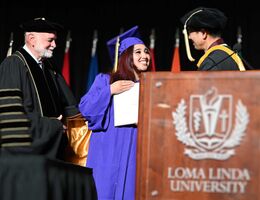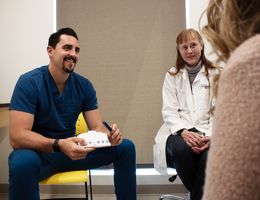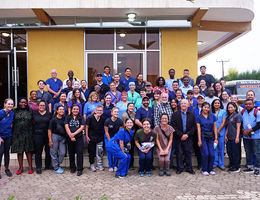

A student at LLU School of Nursing utilizes VR goggles as part of the school’s expanding simulation curriculum.
Loma Linda University School of Nursing students are stepping into a new kind of classroom — one that exists entirely in virtual reality.
Through immersive headsets and interactive software from Oxford Medical Simulation, students now find themselves in lifelike clinical settings where they must assess patients, direct teams, and make split-second decisions. The program, part of the school’s expanding simulation curriculum, mirrors real-world healthcare pressures in a safe, controlled environment.
These virtual reality situations can seem very real, and it’s a wonderful training tool,” said MaryJo Schaarschmidt, DNP, PNP-BC, assistant professor and director of simulation at the School of Nursing. “While VR doesn’t replace in-person clinical experience, it gives students exposure to a wide range of scenarios — caring for patients of all ages, managing different disease processes and care environments, recognizing early signs of patient decline, initiating emergency care, or prioritizing care for multiple patients at once. Many of these situations are rare and might not occur during traditional clinical rotations.”
For Jessica Padilla, MSN, APRN, AGACNP-BC, assistant professor in the School of Nursing and program coordinator for the Adult Gerontology Acute Care Nurse Practitioner program, virtual reality has been particularly valuable in helping students navigate one of the hardest parts of their education: the transition from bedside nurse to provider.
“The role transition from being an RN to a nurse practitioner is really tough,” Padilla said. “When we enter a traditional simulation, students are often most comfortable falling back into their nurse role. But in VR, the only role available is that of the provider. You’re leading the code, giving the orders, and everyone in that virtual room is waiting for your direction.”
According to Padilla, the immersive scenarios foster authentic leadership development by replicating the complexities of clinical practice. “The virtual environment leaves no detail unnoticed,” she said. “For instance, if a student forgets to order an IV and later attempts to order a medication, the system prevents the action and prompts them to address the oversight. This approach allows students to practice accountability and clinical decision-making in a controlled, supportive setting.”
She added that students quickly improved with each session, thanks to the program’s built-in feedback system. “They get a report at the end showing what they did well and what they missed,” Padilla said. “The more they practiced, the more confident and decisive they became.”

That confidence is already translating to students in earlier stages of their nursing education.
Bianca Acevedo-Garcia, a fifth-quarter nursing student, is part of the Student Nurses Assistive Personnel Program, which bridges the journey from student nurse to professional by allowing students to work as patient care assistants in Loma Linda University Health’s adult and children’s hospitals. She said combining hands-on experience from her job with virtual reality training helped her build the confidence to perform her first sterile dressing change on a patient.
“The VR environment gave me more confidence,” Acevedo-Garcia said. “It helped me get familiar with all the equipment, such as chlorhexidine, and knowing how to perform the appropriate technique with each before I got the opportunity in the clinical setting. So, when I actually did it with my preceptor, it wasn’t my first time walking through it.”
She said the realism of the simulation helped her retain what she learned in a way that traditional learning modules never did. “It’s not just watching a video,” she said. “You’re actually doing the work. With VR and observing the nurses on the unit perform it, I remembered the steps when it was my turn — it took a little more time, but it made sense once I was in the real setting.”
Acevedo-Garcia credited the supportive culture at Loma Linda University for giving students opportunities to learn from multiple perspectives. “The nurses I work with and the clinical instructors really push us, but they also make us feel comfortable,” she said. “They’re so supportive. It’s one of the things that makes this place special.”
She also noted that virtual reality has replaced some of the older digital learning modules used in the past. “Before, we had to do videos that were 40 minutes long,” she said. “If I’m being honest, no one really liked doing them. VR is more hands-on and way more engaging — you’re part of it.”
Padilla and Schaarschmidt both see virtual reality as an important evolution in simulation-based learning. It provides hands-on repetition without risk to patients — a benefit that’s especially valuable for rare or high-stakes procedures.
“It really helps reinforce muscle memory of routines such as correctly identifying yourself and your patient, ensuring correct infection control measures, communicating, documenting, and prioritizing- all actions needed to provide safe patient care to every patient every time,” Schaarschmidt said.
Padilla hopes to expand the technology’s use in the future, including mock intubations and central line placements. “It takes students out of their comfort zone — but in a safe way,” she said. “The worst thing that happens is you get kicked out of the virtual room. Then you reset and try again. That’s exactly how real learning happens.”
Learn more about Loma Linda University School of Nursing here.



